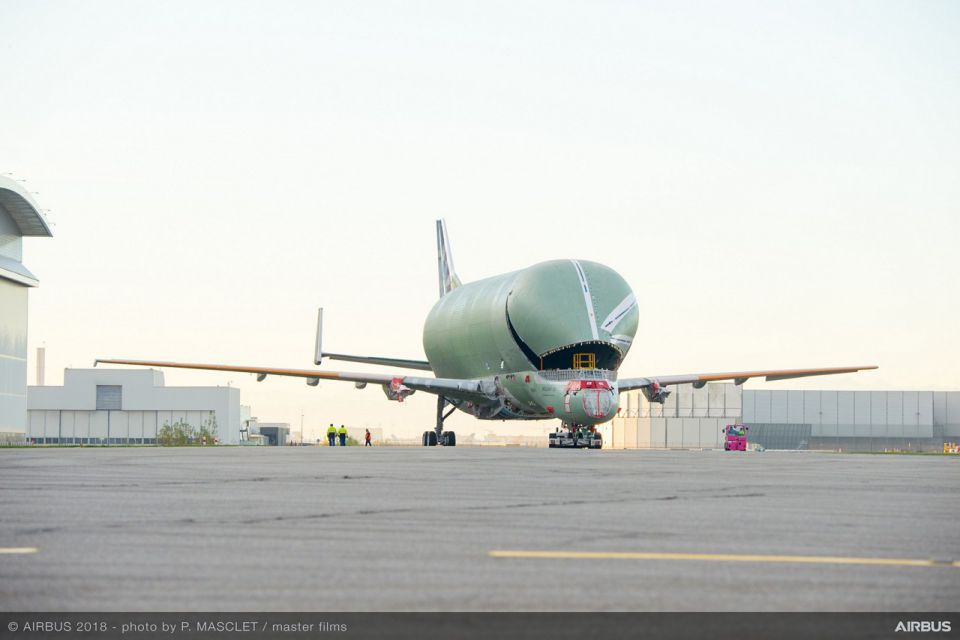Aerospace
The first of five Beluga XLs will enter into service in 2019.!

The new Beluga programme, christened Beluga XL, has successfully passed the latest maturity gate milestone – marking the end of the ‘concept phase’ or design freeze ‘at aircraft level’ which is a key step in any development programme.
The maturity gate review demonstrated that the Beluga XL programme is robust and mature enough to move to the next phase of development, the detailed design phase.
“We are proud of how much we have accomplished, in less than a year after the launch of the programme, with the new and innovative way of working with our suppliers. By working together as a fully integrated team in a single location, we have maximised our efficiency. This milestone paves the way for a successful final assembly start in 2017” said Bertrand George, Head of Beluga XL programme.
The Beluga XL was launched in November 2014 to address the transport capacity requirement to support the A350 XWB ramp-up and other aircraft production rate increases. Based on the A330-200 Freighter with a large re-use of existing components and equipment, the Beluga XL will be powered with Rolls Royce Trent 700 engines. The fleet of five Beluga XL aircraft will provide Airbus with an additional 30 percent extra transport capacity. The first of five Beluga XLs will enter into service in 2019.
Featuring one of the most voluminous cargo holds of any aircraft today, be it civil or military, the current fleet of five A300-600ST Super Transporter (*) aircraft named Beluga, carries complete sections of AIRBUS aircraft, produced at various sites around Europe, to the final assembly lines in Toulouse, Hamburg and Seville.
The fleet of Beluga is operated by Airbus Transport International (ATI), an Airbus subsidiary airline.
- INCREASING THE BELUGA FLEET’S CAPABILITIES
To support the A350 XWB ramp-up and other production rate increases, Airbus is expanding its existing A300-600ST fleet with the development and production of five new Beluga XL aircraft, derived from the company’s versatile A330 widebody product line.
In addition to the significant use of existing components and equipment, Airbus’ new A330-based Beluga will incorporate newly-developed elements including its lowered cockpit, cargo bay structure, and rear and tail section.
The first A330-based Beluga XL aircraft is planned to enter service in mid-2019 – operating in parallel with the existing five-aircraft A300-600ST fleet, which is to be progressively retired through 2025.
Liked it ..!?
share with your friends and family

Aerospace
Boeing Transfers Rocket Stage to NASA, Paving Way for Human Moon Mission

Boeing has achieved a significant milestone by providing NASA with the second core stage of the Space Launch System (SLS) rocket.
This crucial component, crafted at NASA’s Michoud Assembly Facility (MAF), is set to propel the Artemis II crew into lunar orbit, marking humanity’s return to deep space after a 50-year hiatus.
The monumental Boeing-built rocket stage, the largest element of the Artemis II mission, will embark on a journey aboard the Pegasus barge, traveling 900 miles to NASA’s Kennedy Space Center.
Comparison of two legendary aircraft B777x vs B747 aircraft:Click here
Upon arrival, it will be meticulously integrated with other essential Artemis II components, including the upper stage, solid rocket boosters, and NASA’s Orion spacecraft within the iconic Vehicle Assembly Building. This intricate integration process is a vital step toward the eagerly anticipated Artemis II launch, slated for 2025.
“Boeing-built products helped land humankind on the moon in 1969, and we’re proud to continue that legacy through the Artemis generation,” remarked Dave Dutcher, vice president and program manager for Boeing’s SLS program. “Together, with NASA and our industry partners and suppliers, we are building the world’s most capable rocket and paving the way to deep space through America’s rocket factory in New Orleans.”
NASA, Lockheed Martin Reveal X-59 Quiet Supersonic Aircraft:Click here
The delivery of Core Stage 2 marks a significant achievement in the evolution of the SLS rocket. Towering over 200 feet and powered by four RS-25 engines, this core stage, coupled with two solid-fueled booster rockets, will generate a staggering 8.8 million pounds of thrust. This immense power is crucial to launching Artemis II and future missions into the vast expanse of space.
The SLS rocket stands unparalleled in its capability to transport both crew and substantial cargo to the moon and beyond in a single launch. Its extraordinary capacity will facilitate the delivery of human-rated spacecraft, habitats, and scientific missions to destinations including the moon and Mars, ushering in a new era of space exploration.
-

 Travel1 week ago
Travel1 week agoAir India to Expand US Operations with Three New Routes After a Decade
-

 Travel2 weeks ago
Travel2 weeks agoWhy We Should Avoid These Stamps in a Passport
-

 Airlines1 month ago
Airlines1 month agoInvestigations Reveal Fake Chinese Titanium in Boeing and Airbus Jets
-

 Tech4 weeks ago
Tech4 weeks agoChina’s CATL Plans 1,800-Mile Electric Plane Launch by 2027
-

 Airport3 days ago
Airport3 days agoTop 10 Largest Airports in the World by Size
-

 Aerospace4 weeks ago
Aerospace4 weeks agoChina’s Fighter Jets Turn Wings into Autonomous Drones
-

 Airlines4 days ago
Airlines4 days agoAir India Rolls Out A350s for Delhi-New York JFK and Newark Routes
-

 Defence3 weeks ago
Defence3 weeks agoBoeing Enhances Chinook with New Engines and Block II Upgrades at $96 Million







